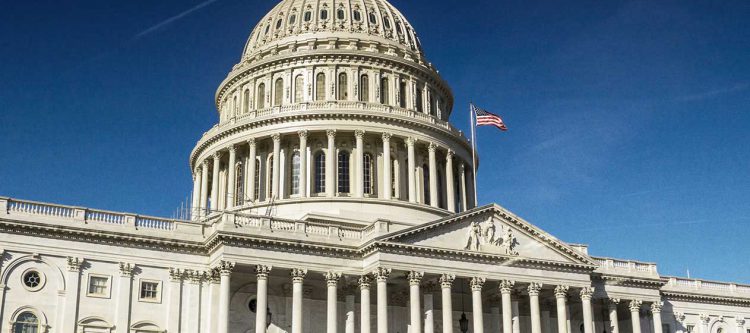Six DHS preparedness grants to help fund resilient communications equipment

As government agencies across the United States respond to the COVID-19 pandemic, there are several new and existing sources of funding to support these rapidly evolving, multi-agency efforts where communications will undoubtedly play a key role.
Earlier this week, the Senate passed a new emergency funding package totaling $340 billion, which is expected to officially clear the House today. And previously in February, the Department of Homeland Security (DHS) announced the release of nearly $1.8 billion in preparedness grant funding.
Of the recently released and expanded DHS grant programs, we’ve identified six key funding sources that your organization can use to specifically support resilient communications equipment and initiatives during COVID-19 as well as future natural and man-made disasters.
- Emergency Management Performance Grant (EMPG)
Total funding available in FY 2020: $355 million, with $100 million additionally allocated for COVID-19 response efforts
EMPG assists state, local, tribal, and territorial governments in enhancing and sustaining all-hazards emergency management capabilities. These grants can be used to fund efforts that support operational communications and coordination, intelligence and information sharing, risk and disaster resilience, and communication infrastructure systems, amongst others.
While the full application and details are available online, examples of communication projects that could be funded through EMPG grants include the development of statewide communication interoperability plans (SCIP), National Incident Management System (NIMS)-compliant training and exercises to test emergency communications capabilities, and the physical hardening of infrastructure systems and emergency communications.
As communities stand up temporary hospital and testing facilities for COVID-19 patients, the increased activity at these sites is also putting a burden on primary communications systems used for essential functions like patient control, supply distribution, and security. Agencies looking to apply EMPG funds to COVID-19 response efforts could request equipment to ensure resilient and redundant communications at medical facilities.
- State Homeland Security Program (SHSP)
Total funding available in FY 2020: $415 million
SHSP grants support the implementation of risk-driven state homeland security strategies to enhance national resilience and rapidly recover from natural and man-made incidents. While states are required to dedicate 25 percent of SHSP funds to law enforcement terrorism prevention activities, eligible equipment and initiatives often serve multiple purposes that could support overall agency communications enhancements.
State Administrative Agencies (SAAs) can apply for funds to purchase communications equipment and accessories such as smartphones, tablets, wearables, headsets, remote Bluetooth sensors, and ruggedized cases. This program could also fund projects to expand dispatch coverage and other communications capacity enhancements. State and local agencies and even non-profit organizations are encouraged to apply for sub-grants from SAAs, so these projects are not just limited to the state level. You find more details about this program online.
- Urban Area Security Initiative (UASI)
Total funding available in FY 2020: $615 million
UASI grants enhance regional preparedness and capabilities in 32 high-threat, high-density areas. Similar to SHSP, SAAs representing high-threat areas are required to dedicate 25 percent of UASI funds to law enforcement terrorism prevention activities specifically, and note any dual-use benefits for any requested funds.
State and local agencies as well as nonprofit organizations should review high risk sites — like places of worship or stadiums — and determine which resilient and redundant forms of communications could support a multi-agency incident response. In addition to equipment like smartphones, tablets, wearables, and other broadband or Bluetooth devices, this grant could also support training and exercise programs to prepare for potential threats. More details are available online.
- Operation Stonegarden Program (OPSG)
Total funding available in FY 2020: $90 million
OPSG grants are focused on enhancing cooperation and coordination among
U.S. Customs and Border Protection and other federal, state, local, tribal, and territorial law enforcement agencies to improve overall border security at both the northern and southern land borders, as well as in states and territories with international water borders.
Given the frequent communications challenges in austere and remote border regions, this grant could support programs and equipment designed to enhance agencies’ joint technical and operational readiness, especially as National Guard units are being deployed to the U.S. southern border, U.S. northern border and other hotspots. Like SHSP and UASI, state and local organizations in priority border areas must request funding through their SAA. More information on tiered priority border areas can be found online.
- FEMA Disaster Relief Fund
Total funding available through COVID-19 package: $45 billion
As more and more states declare emergency status in response to COVID-19, FEMA’s Disaster Relief Fund has been expanded to reimburse vital activities like medical response, personal protective equipment, National Guard deployment, coordination of logistics, safety measures, and community services. In the near term, emergency managers could use these funds to ensure public health communications needs are integrated into regional and statewide emergency operations centers as well as unified command centers at medical facilities.
- Assistance to Firefighters Grant Program (AFG)
Total funding available through COVID-19 package: $100 million
Separate from FEMA’s Disaster Relief Fund, AFG specifically supports firefighters and other emergency medical service personnel responding to fire and other related hazards during critical disasters. While the program typically supports training and equipment designed to enhance operational efficiency, interoperability, and community resilience, the COVID-19 package will likely be directed towards urgently-needed personal protective equipment, supplies, and reimbursements. Communities with aging communications equipment may consider applying these funds towards radios, smartphones, or other tools that could enhance interoperability and safety for all emergency personnel.
As of April 23, 2020, FEMA released an additional $100 million to firefighters on the front lines of the coronavirus pandemic for personal protective equipment and supplies.
Additional resources
Here are some additional resources on researching and submitting your grant application or federal reimbursement:
- Full details on DHS’s preparedness grant programs are available at www.dhs.gov and at www.fema.gov/grants. Note that all preparedness grant applications must be made through the Non-Disaster (ND) Grants system portal before April 15th at https://portal.fema.gov.
- Information on FEMA reimbursements for disaster-related funds can be found at https://www.fema.gov/.
- A listing of DHS, FEMA, and all other open grant programs is available at www.grants.gov.








No Comment